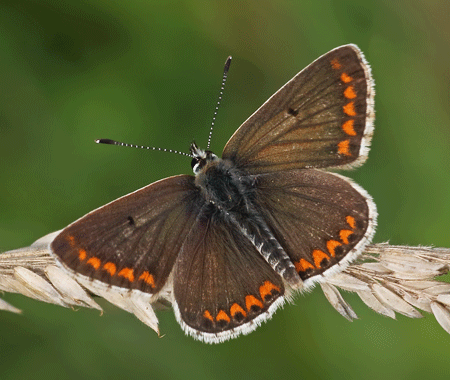 | Butterfly Conservation Saving butterflies, moths and our environment | Upper Thames Branch |  |
Brown Argus (Plebeius agestis) | ||||||||||||||||||||
| Description | ||||||||||||||||||||
| Wing span: 25-31 mm. The Brown Argus is an attractive butterfly, particularly when fresh, with bright orange marks contrasting with the dark chocolate-brown wings and the white wing borders. The sexes are similar; the female is larger. The female can have blue thoracic hairs, but never has blue scales (a means of differentiating it from the female Common Blue). It is primarily found south-east of a line between the Severn and the Humber, although it has been spreading further north in recent years. It occurs in small, compact colonies, and is not a great wanderer; adults only travel up to a few hundred feet from where they emerged. Colonies are typically found on chalk or limestone downland where the larval food plant is abundant, but they can also be found on heathland and in open woodland. | ||||||||||||||||||||
| Images (click to enlarge) | ||||||||||||||||||||
| ||||||||||||||||||||
| Life Cycle | ||||||||||||||||||||
| This species generally has two broods a year in central and southern England, and there is sometimes a third. Adults emerge first in central and southern England in early May, peaking at the end of May and beginning of June, and giving rise to a second brood that emerges at the end of July. Both broods are protracted, so it is possible for second-generation adults to be on the wing before the last first-generation adults have died. The larva is the over-wintering stage. | ||||||||||||||||||||
| Larval Foodplants | ||||||||||||||||||||
| The main foodplant on calcareous soils is Common Rock-rose (Helianthemum nummularium). Common Storks-bill (Erodium cicutarium) and Doves-foot Cranes-bill (Geranium molle) are used on other sites. | ||||||||||||||||||||
| Nectar Sources | ||||||||||||||||||||
| Adults feed primarily on Marjoram, Ragwort, Thyme and White Clover. | ||||||||||||||||||||
| UK Conservation Status | ||||||||||||||||||||
| Least Concern | ||||||||||||||||||||
| Earliest UTB first sighting (since 2004) : 4th April | ||||||||||||||||||||
| Mean UTB first sighting (since 2004) : 5th May | ||||||||||||||||||||
| Distribution and Sites | ||||||||||||||||||||
 Key |
| |||||||||||||||||||
| Related Species | ||||||||||||||||||||
| ||||||||||||||||||||
Copyright © Butterfly Conservation Upper Thames Branch 2007 - 2025. Privacy and Copyright Statement
Butterfly Conservation : Company limited by guarantee, registered in England (2206468)
Registered Office: Manor Yard, East Lulworth, Wareham, Dorset, BH20 5QP, Tel: 01929 400 209
Charity registered in England & Wales (254937) and in Scotland (SCO39268)
Butterfly Conservation : Company limited by guarantee, registered in England (2206468)
Registered Office: Manor Yard, East Lulworth, Wareham, Dorset, BH20 5QP, Tel: 01929 400 209
Charity registered in England & Wales (254937) and in Scotland (SCO39268)




